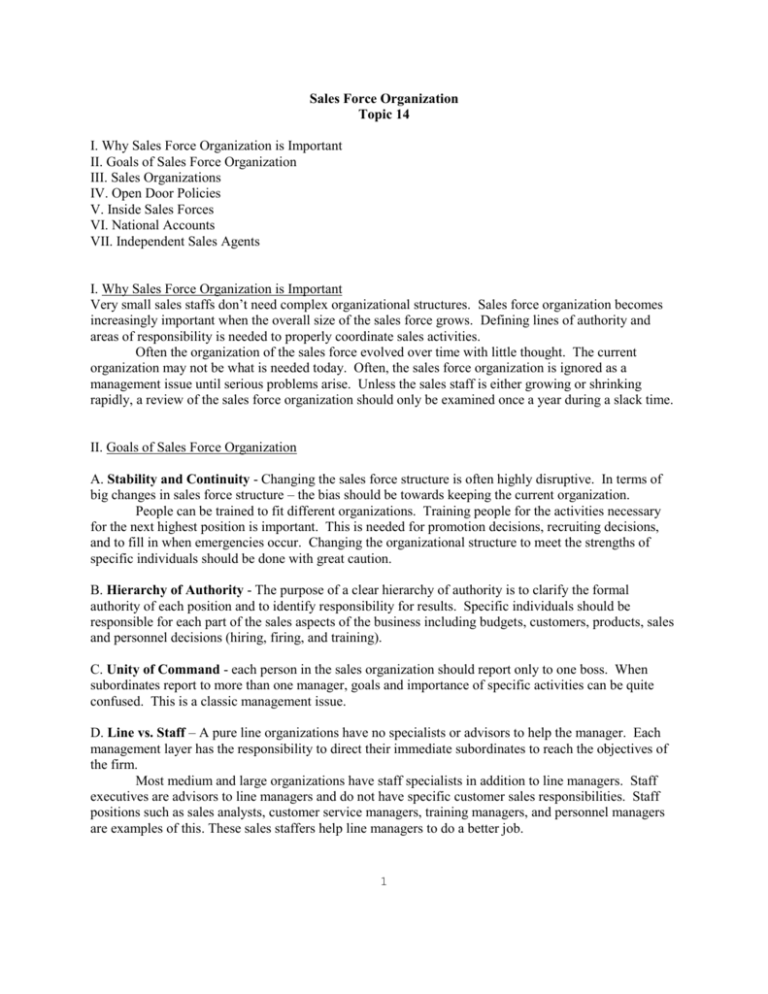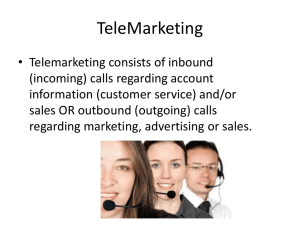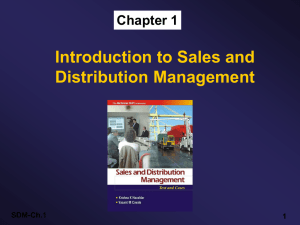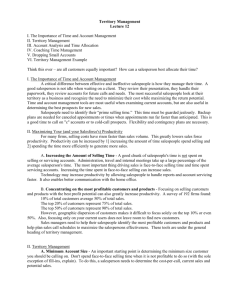Topic 14 Sales Force Organization Lecture Notes
advertisement

Sales Force Organization Topic 14 I. Why Sales Force Organization is Important II. Goals of Sales Force Organization III. Sales Organizations IV. Open Door Policies V. Inside Sales Forces VI. National Accounts VII. Independent Sales Agents I. Why Sales Force Organization is Important Very small sales staffs don’t need complex organizational structures. Sales force organization becomes increasingly important when the overall size of the sales force grows. Defining lines of authority and areas of responsibility is needed to properly coordinate sales activities. Often the organization of the sales force evolved over time with little thought. The current organization may not be what is needed today. Often, the sales force organization is ignored as a management issue until serious problems arise. Unless the sales staff is either growing or shrinking rapidly, a review of the sales force organization should only be examined once a year during a slack time. II. Goals of Sales Force Organization A. Stability and Continuity - Changing the sales force structure is often highly disruptive. In terms of big changes in sales force structure – the bias should be towards keeping the current organization. People can be trained to fit different organizations. Training people for the activities necessary for the next highest position is important. This is needed for promotion decisions, recruiting decisions, and to fill in when emergencies occur. Changing the organizational structure to meet the strengths of specific individuals should be done with great caution. B. Hierarchy of Authority - The purpose of a clear hierarchy of authority is to clarify the formal authority of each position and to identify responsibility for results. Specific individuals should be responsible for each part of the sales aspects of the business including budgets, customers, products, sales and personnel decisions (hiring, firing, and training). C. Unity of Command - each person in the sales organization should report only to one boss. When subordinates report to more than one manager, goals and importance of specific activities can be quite confused. This is a classic management issue. D. Line vs. Staff – A pure line organizations have no specialists or advisors to help the manager. Each management layer has the responsibility to direct their immediate subordinates to reach the objectives of the firm. Most medium and large organizations have staff specialists in addition to line managers. Staff executives are advisors to line managers and do not have specific customer sales responsibilities. Staff positions such as sales analysts, customer service managers, training managers, and personnel managers are examples of this. These sales staffers help line managers to do a better job. 1 E. Span of Control - are the number of subordinates that are supervised by each manager. Recent trends have widened spans of control both in sales organizations and more general marketing organizations. Narrow spans allow closer control. But, the disadvantage is more isolation from customers, competitors and outside forces. Narrower spans of control will raises costs and makes changes in strategy slower. In general, the most successful firms have fewer layers of management. Flat structures have problems also. Individual salespeople and front line managers have less supervision. Better training and better people are needed. There are fewer promotion opportunities so challenging and rewarding salespeople are more difficult (as is retaining the best people). F. Centralization Vs. Decentralization - who should control the sales force, top management or field sales managers? With centralized organizations, the sales force is primarily controlled by the home office. There are many strict policies and procedures. When there is a more decentralized organization, line sales managers have more freedom to adjust methods and strategies to meet specific customer needs and to adjust to specific salesperson strengths. However, the firm may be having a multitude of strategies in the market which can also cause trouble. Decentralized decision making along with flatter sales organizations promotes more responsive decision making and accountability in the field. This can increase the motivation of the sales force and lead to faster reaction to changes in the market. G. Basic Conflict Between Sales/Marketing and Production or Logistics - Salespeople want to sell, both for personal reasons (commissions & bonuses) and to get the customer what they need and when they need it. Production managers are paid for having no/few defects and having low cost per units. In production, if you can produce regular, steady amounts you can almost always shape your production process to lower unit costs. Costs tend to go up if you have irregular production process. Thus, there is a basic conflict between getting the customers the units they need, when they need them and the goal of the production manager to lower unit costs. III. Sales Organizations Sales forces are most often organized geographically. Other organizations are around customers, products or functional specializations within geographic areas. A. Geographic Specialization - is most common. Advantages are geographically smaller territories which lower time and travel costs. Confusion is minimized since the responsibility for each territory is clearly fixed. Problems are the lack of expertise about customers and products that can occur. Salespeople may also focus on products and customers that they are familiar with or can handle easily. This may not be the most profitable allocation of time and resources. However, close supervision, well designed incentives and good training can mitigate these problems. B. Product Specialization - Salespeople specialize by selling only a few products within the organization's product line. This can increase the salesperson's product expertise. The selling process may also be quite different for different products. Last, the members of buying centers may be quite different for different products. However, territory sizes are larger which raises costs. Duplication of customer calls can also cause problems (coordination between separate sales forces is seldom done). Also, different sales organizations are competing for the same budgetary resources. 2 C. Customer Specialization - salespeople sell the entire product line to selected types of buyers. This structure is more market driven and works best when buyers are geographically concentrated. The most important advantage is a better understanding of customer special needs and problems and become experts in a particular industry. D. Functional Specialization - Focuses on the jobs or functions performed by customer contact people. Some salespeople focus on sales, others on customer service, customer training and other areas. Major problem of this approach is the lack of coordination. Customers having training or service problems may not have these problems communicated to the people trying to make the sale. Although functional specialization is common to some degree in most medium and large sales staffs, coordination of the information is critical. IV. Open Door Policies Unless you own the company you are reporting to someone else who has the ability to fire you. When you work for someone, they expect you to follow orders and to put in a productive days work. Insubordination is a firing offense almost everywhere. Although some people think that “everyone’s opinion is important,” this is seldom the case. You could be right in a marketing decision, and still get fired for failure to follow the orders or policy of your boss/company. A superior having an “open door policy” or “suggestions are always welcome policy” does not mean they won’t terminate people who fail to follow instructions or adhere to the company strategy. Often, “open door policies” are there in order to get an early warning on individuals within the company who are violating the law or company policy. An “open door policy” can serve as a warning light that there are problems in the company. But, if it is a “he said - she said” situation, companies almost always side with the person with the highest rank, or who bring in the most cash for the company (although most will look at concrete evidence). There can be debate, sometimes heated, on the wisdom of alternative marketing and sales strategies. However, once the decision is made by those in authority the debate is usually “over.” Individuals griping about, or worse yet failing to follow the decided upon strategy are often looked upon as troublemakers and fired. The strategy will probably be reconsidered when the results come in. But once a strategy is decided upon the company tries its best to effectively implement the strategy. In general, if you go over your bosses’ head in a policy dispute you should realize you are risking your job. Going over your bosses’ head by using an “open door” or “open suggestion” policy is putting a bulls-eye on your head. Your boss will typically resent it and look for the earliest opportunity to fire you for it. Companies also expect junior employees to go through normal communication channels. Going over the head of your boss, without a really excellent reason, is usually a highly risky career move. If you choose to do this you may be well served to be looking for another job. The internet generation has been firing off the cuff criticisms for most of their life. They also think that relatively uninformed opinions are just as important as those held by decision makers. This often results in a rude awakening when they get a full time job. V. Inside Sales Inside sales (phone or internet based) has a tremendous advantage over field sales forces. The inside salesperson can contact far more current or prospective clients per hour than a field sales person. Once you get the telemarketing and internet situation set up the cost to maintain a field sales force is usually lower than an outside sales force. Some customers cannot be served cost-effectively by a field sales force. Based on the cost structure it is internet/telemarketing or nothing. Effectively coordinating between an inside and outside sales force can multiply the effectiveness of both groups – or drive customers away. It is critical that the information system allow the person 3 accessing the customer’s account to follow what different people within the firm have done with that customer. Otherwise there is tremendous frustration by the customer and the account is often lost. A lot of companies have an inside sales force to handle a lot of routine activities for larger clients with 100% support for smaller clients. Telemarketing can handle customer service, help prospect and identify sales leads, and provide sales support to service small customers, and sell peripheral or secondary product lines. They also provide a direct response component to advertising. The primary advantage is cost-effectiveness. Telemarketing can handle routine business, alert the sales staff when face-to-face calls are needed, and alert the salespeople to problems. Routine orders can also be speedily handled by phone staffs. The cost per customer contacted is quite low. There are Problems Associated with Inside Sales Forces: A: Field salespeople can feel threatened. Will the field sales staff be cut? B: Who gets the commissions? Careful design of reward structures is critical (explain). C: Organization is also critical. Assigning telemarketing people to customers and territories is just as critical as it is for field salespeople. Not having enough telemarketing staff can lose customers just like not having enough field salespeople. The most effective use of telemarketing also requires close ties with the field sales force. Handling incoming calls and current business is one set of skills. Soliciting leads and searching for new business is a different skill set. Motivating and retaining telemarketing people are also major problems. Telemarketers do not have freedom of movement and may have to make 20-30 calls per hour. Telemarketers often are paid less and are considered second-class citizens. However, performance bonuses and other recognition tools can counter act this problem (discuss). Do-Not-Call applies only to residential lines. VI. National Accounts A national accounts program is an effort to provide services and products necessary to sell and establish a long-term relationship with key customers (also referred to as key or major account programs). They are used because of concentration of purchasing power and the increased use of fewer suppliers. So, a handful of accounts can be critical to the success or failure of a firm. Sole-supplier relationships are used by purchasers to reduce costs and to have greater control over quality. However, there is increased risk with this practice. A JIT relationship can be a long-term, single supplier relationship with much greater sharing of cost, operations and production information. National account programs are generally quite costly. Customers qualifying for national account status purchase in significant volume and also often: have multiple people in the buying process; purchase centrally; desire a long-term, cooperative working relationship; and expect specialized attention and service. Firms often utilize their existing sales force in a national accounts effort. This is both less risky and less costly than setting up a separate sales force. However, under this set up national accounts are not very likely to be treated significantly differently than other accounts. Sometimes national accounts are the responsibility of sales managers. This is relatively low cost and managers have the authority and power to meet special customer needs. Separate sales forces are sometimes designed. This is a high cost strategy. Sometimes this involves forming special sales teams which can be made up of existing salespeople. A sales team can add members with special technical expertise and product knowledge. 4 VII. Independent Sales Agents Definition = salespeople paid on commission who are not employees of the firm. They are independent businesses given exclusive contracts to sell within specific geographic areas. They neither own nor take physical possession of the goods. They are always compensated by commission. They are frequently used to develop new markets and frequently have specialized knowledge of either customers or products. Reps also provide excellent flexibility and lower overhead costs, especially benefits and government regulation. Independent Reps are usually given higher commissions and the firm does not control their actions like they do company employees. It is difficult to gain special effort to move certain products (including market research, credit, and collection). Independent reps also do not provide information on the competitive and market environment under most circumstances. However, administration costs are far lower and there are no selling overhead costs (travel, salary, entertainment, etc...). This leads to lower break-even points, but often lower profits with high sales levels. However, they are often the only way to cover secondary markets or are the only alternative for small firms. Discuss from the reps perspective and the problems with sandbagging products. Example: A company can contract with an independent rep to handle sales in Wyoming – a territory with limited sales. The contract specifies that the independent rep is paid a 10% sales commission payable when payment is collected from the customer. Costs = Revenues x 0.10 Another option is hiring a company salesperson to cover this territory. The salesperson would cost $65,000 in salary and benefits and earn a 1% sales commission. Annual Cost = $65,000 + (.01 x Revenues). The break-even sales level between these two options is: 0.1x = $65,000 + .01x, where x = revenues. Solving we get: .09x = $65,000 X = $722,222.22. At sales levels lower than this amount the contribution of the territory is higher with the independent rep. At sales levels higher than this the contribution is higher with the company salesperson. Often companies use independent reps to develop a marginal territory and replace them if the sales level exceeds break-even. 5











